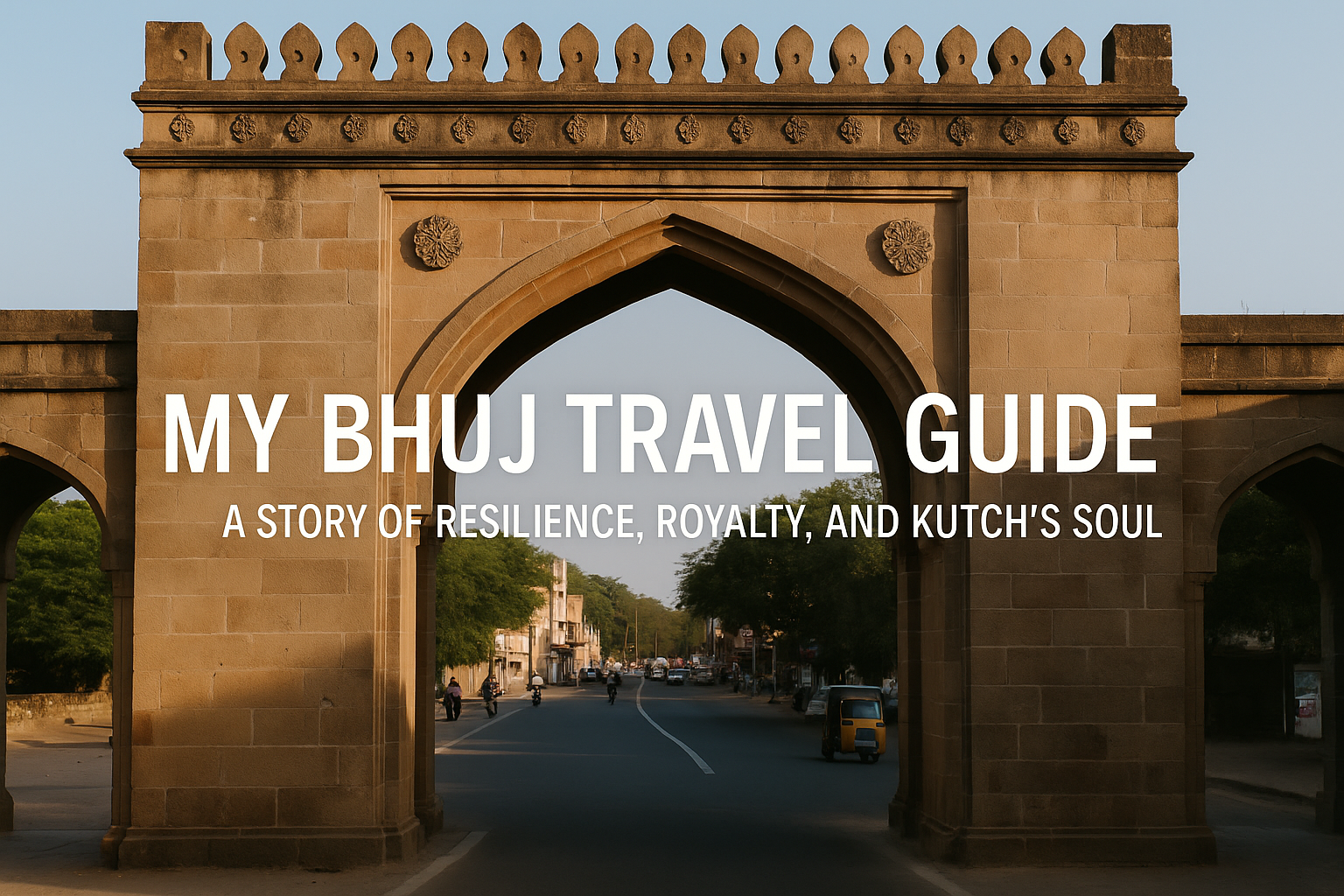Some journeys are about reaching a destination; others are about the journey itself. My trip to Bhuj was the latter. I chose to travel by train from Delhi, a conscious decision to slow down, to watch the landscapes of India unfold, and to reduce my carbon footprint. It was a journey fueled by the rhythmic clatter of wheels and the anticipation of meeting new friends, Parth and Amar, who had promised to show me the true heart of Kutch.
For those planning to discover this resilient city, here’s a quick overview. A train journey is a wonderful way to arrive. For a truly unique stay, I highly recommend The Bhuj House, a Parsi heritage homestay. The city’s must-visits include the royal Prag Mahal and the deeply moving Smriti Van earthquake memorial. And for food, you cannot leave without trying the local Dabeli and a traditional Gujarati-Kutchi thali at Apna Dining Lodge.
A Stay with a Story: The Bhuj House
My first taste of Bhuj’s unique character was my accommodation. The Bhuj House is one of the last remaining Parsi homes in the city, a beautifully restored heritage property that tells a story of migration, memory, and elegant architecture. Staying here wasn’t just about finding a room; it was about supporting the preservation of a minority community’s precious legacy. Waking up within its quiet, storied walls set the tone for my entire exploration: to look for the stories behind the facades.
Echoes of Royalty and Resilience: Palaces and Planning
Bhuj is a city with a history stretching back 5,000 years to the Indus Valley Civilization at nearby Dholavira. Founded in 1510 CE by Rao Khengarji I, it became the capital of the Jadeja Rajput dynasty. I explored this royal legacy at the magnificent Prag Mahal and the exquisite Aina Mahal (Palace of Mirrors). Hearing insights from a member of the royal family, Mayurdhwaj Sinh Jadeja, brought these stone walls to life.
But Bhuj’s genius lies not just in its palaces, but in its planning. As architect Shriraj Bhai explained, the city was designed around the life-giving Hamirsar Lake. The forts, gates, and catchment systems were part of an ancient, sustainable urban model. Today, this wisdom lives on as you see locals swimming, celebrating, and gathering by the lake—the city’s living, breathing heart.
The Sacred and the Serene: A Visit to the Swaminarayan Temple
A short walk from the lake is the stunning, white-marble Swaminarayan Temple. I learned about the movement’s founder, Ghanshyam Pandey, and its global influence. Standing inside both the old and new temples, I felt a profound sense of peace, a spiritual calmness that offered a beautiful contrast to the city’s bustling energy.
A Taste of Kutch: From Thalis to Street Food Feasts
To know a place is to taste it, and in Bhuj, my friends made sure I did. Our mornings began with classic Kutchi breakfasts: one day, it was hot Jalebi with spicy Fafda and Kadhi at a place called Khavda; the next, soft Khaman-Dhokla with yogurt.
For lunch, we went to a local institution, Apna Dining Lodge, for a full Gujarati-Kutchi thali. The Sev Tameta nu Shaak (a sweet and tangy tomato curry), hearty Rotla, cooling Chaas, and rich Shrikhand was a culinary delight.
But the real magic happened during our evening street food crawl. We started with the legendary Mama Ji’s Dabeli, a 70-year-old stall serving the iconic sweet and spicy bun. We tried toasted Dabeli, a crunchy local fusion called Bhel wali Roti, and savory Handvo cakes. We ended at Khavda Sweets, trying Roasted Peda and Gulab Pak. Here, food is not just flavor; it is inheritance and identity.
The Wound That Heals: Understanding Bhuj at Smriti Van
No journey to Bhuj is complete without understanding its story of profound loss and incredible resilience. I visited Smriti Van, the memorial dedicated to the victims of the devastating earthquake of 26th January 2001.
The visit is deeply emotional. The museum explains the science of the earthquake—the meeting of tectonic plates, the epicenter—but it’s the personal stories on the memorial walls that stay with you. The complex also includes a vast Miyawaki forest, a symbol of rebirth and healing. As I stood at the Sunset Point, watching the light return to the sky, I understood that this memorial isn’t just about remembering a wound; it’s about celebrating the city’s unbreakable spirit and its journey back to the light.
Farewell from a Rooftop: Final Reflections
My last evening was spent at Bari Rooftop Café, a quiet spot overlooking the city. Sipping tea as the sky changed colors, I reflected on my journey. An unexpected downpour earlier that day had washed the city clean, a poetic reminder of its ability to weep and then dance again.
Bhuj taught me about resilience, memory, and the joy of connection. As I was leaving, Parth gave me a small test on Kutchi words, a playful farewell. I may have failed the test, but I left with a full heart, forever grateful to the friends who showed me their city through their eyes.
In Jaipur, I had found royalty. In Bundi, I had found secrets. But in Bhuj, I found a soul—tough, tender, and deeply inspiring.

Leave a Reply